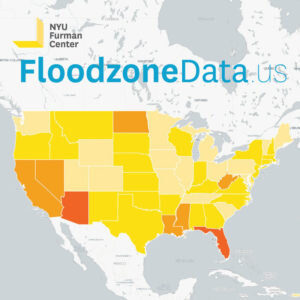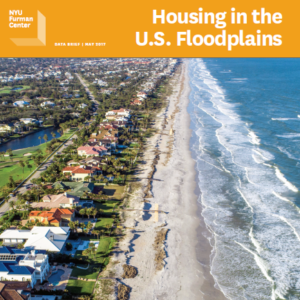New analysis from NYU Furman Center also finds that Florida, Texas, and California have highest risk to housing from flooding
Press Release – New York, NY — Today, the NYU Furman Center announced the launch of FloodzoneData.us, an online data tool describing the people and housing located in the nation’s floodplains. The interactive map and data downloads make information available at the state, county, and Census tract levels. As sea levels rise and storms intensify due to climate change, FloodzoneData.us is a resource to help policymakers and communities plan for the effects of flooding.
The NYU Furman Center’s FloodzoneData.us combines housing and population data with FEMA maps of the 100-year floodplain (the term for areas with a one percent probability of flooding each year) and the 500-year floodplain (areas with a 0.2 percent probability of flooding each year).
“Severe climate events are becoming more common, and policymakers in areas across the country are grappling with how to address the risks to residents and communities from flooding,” said Jessica Yager, Executive Director of the NYU Furman Center. “Having access to data is crucial for effective disaster response and resilience planning. By providing detailed information about the population and housing stock in the floodplains, we hope this tool will help policymakers and communities plan for a more resilient future.”
According to a new analysis released in conjunction with FloodzoneData.us, Florida, Texas, and California have the largest numbers of housing units in the 100-year floodplain. In Florida, nearly two million occupied housing units are located in the 100-year floodplain; Texas has about 612,000 housing units and California has about 388,000 units in the 100-year floodplain.
The NYU Furman Center also found that the majority of the housing units in the combined 100- and 500-year U.S. floodplains are single-family homes (64%) and are owner-occupied (62%).
The age of housing units in the U.S. floodplain, and thus how likely they are to be compliant with flood-resistant construction standards, varies widely; 22% of units in the 100-year floodplain were built before 1960 and therefore are less likely to be built to standards created with FEMA’s 1968 National Flood Insurance Program. Units built after 2000, which are more likely to be compliant, account for the smallest share (19%) of housing in the 100-year floodplains.
A large share of all U.S. public housing units (9%) are located in the combined 100- and 500-year floodplains. In addition, 8% of all privately-owned subsidized rental housing units in the U.S. are located in the combined 100- and 500-year floodplains.
“The Kresge Foundation is pleased to support this effort to bring important data to the public, policymakers, and researchers about the people and housing at risk in our nation’s floodplains,” said Jalonne L. White-Newsome, senior program officer at The Kresge Foundation. “We hope this tool can be used to assist in both short-term and long-term planning to address the needs of communities living with the risk of flooding. This is a crucially important objective for a growing number of jurisdictions across the country, especially as climate change increases the frequency and intensity of severe weather events.”








